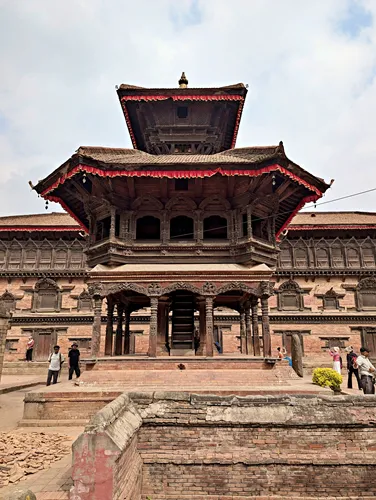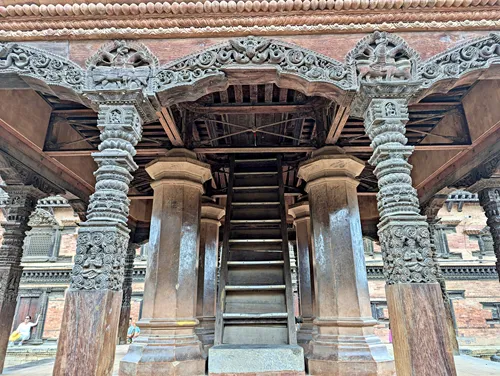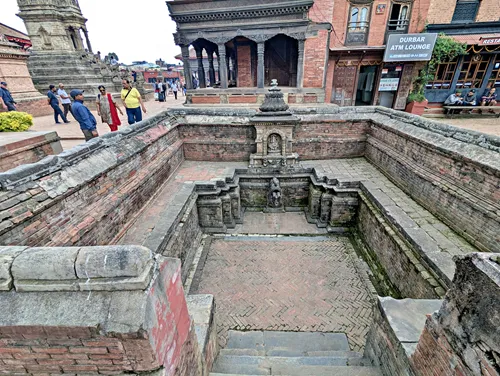Chyasalin Mandap Pavilion & Layaku Hiti: Your Guide to Bhaktapur's Landmarks - Nepal Purple Travel Guide
(map, reviews)
This is Premium Content! To access it, please download our
Backpack and Snorkel Purple Travel GuideIf you are templed out at this point, don’t worry, you get a short break. Chyasalin Mandap Pavilion is not a temple, and neither is Layaku Hiti.




Here at Backpack and Snorkel Travel Guides, we typically promote self-guided walking tours.
But we realize that not everybody likes to walk by themselves in a foreign city. So, just in case that you rather go with ab guide: NO PROBLEM! Please see the Viator tours below.
free GuruWalk tours
paid Viator tours
Origin of the Name Chyasalin Mandap
The name Chyasalin Mandap roughly translates to ‘Eight-Cornered Pavilion’, derived from the Newar words ‘Chya’ (eight) and ‘Salin’ (cornered or sided). Its octagonal shaped roof sets it apart from the more common square or rectangular Newar structures and adds a geometric balance to the layout of the square.
Historical Background of Chyasalin Mandap
Chyasalin Mandap was built in the 17th century, most likely during the reign of King Bhupatindra Malla of Bhaktapur (who ruled from 1696 to 1722). While there are local legends suggesting that King Srinivasa Malla of Patan may have initiated its construction as a symbol of friendship, the architectural style, inscriptions, and historical records most strongly associate the pavilion with King Bhupatindra Malla, who was a great patron of the arts and architecture in Bhaktapur.
The pavilion’s unique location, directly between the Pashupatinath Temple and the 55-Window Palace, is steeped in legend.
According to a long-held belief in Hindu tradition, it is inauspicious to live directly in front of a powerful deity. Since the Pashupatinath Temple housed such a divine presence, Chyasalin Mandap was strategically constructed to serve as a spiritual barrier, shielding the royal palace from the direct energy of the temple.
Over the centuries, this elegant pavilion became more than just symbolic. It served as a platform for poetry contests, including one famously hosted by King Bhupatindra Malla and his consort. It was also used to receive royal guests, observe festivals, and take in sunset views over Bhaktapur Durbar Square.
The original pavilion was destroyed in the 1934 earthquake. However, it was reconstructed between 1989 and 1992 by a team of German architects, using both steel reinforcements and salvaged materials from the original structure. Thanks to this restoration, Chyasalin Mandap withstood the 2015 earthquake without damage, standing today as a proud and resilient piece of Bhaktapur's architectural legacy.
Architectural Features of Chyasalin Mandap
Chyasalin Mandap stands on a raised platform and is supported by beautifully carved wooden columns. The pavilion features a two-tiered pagoda-style roof and intricately detailed struts and cornices, all echoing the artistic traditions of the Malla era. The upper roof is square while the lower roof is octagonal, and the building itself is square, too.
Layaku Hiti
The Layaku Hiti, also known as the Palace Spout, is the traditional stone water conduit situated adjacent to the Chyasalin Mandap Pavilion in Bhaktapur Durbar Square.
Origin of the Name Layaku Hiti
The term ‘Layaku’ translates to ‘palace’ in the Newar language, indicating its historical association with the royal palace complex. This hiti was constructed to supply water for the worship of nearby temples, including the sacred Taleju Temple located within the inner court of the palace.
Architectural Features of Layaku Hiti
Architecturally, Layaku Hiti is notable for its intricate stone carvings. Above the spout is a depiction of Panchamukhi Bhairava, a representation of the fierce and powerful deity Bhairava, a manifestation of Lord Shiva, with five faces. The term ‘Panchamukhi’ literally means ‘five-faced’ in Sanskrit.
The mouth of the conduit a makara (crocodile elephant composite) with a crocodile standing on its back. The spout is adorned with various mythological creatures associated with water, reflecting the rich artistic heritage of the Malla period.
Although Layaku Hiti no longer functions as an active water source, it remains a significant cultural and historical landmark.
Back to your self-guided tour
Author: Rudy at Backpack and Snorkel
Bio: Owner of Backpack and Snorkel Travel Guides. We create in-depth guides to help you plan unforgettable vacations around the world.
Other popular Purple Travel Guides you may be interested in:
Like this Backpack and Snorkel Purple Travel Guide? Pin these for later:





